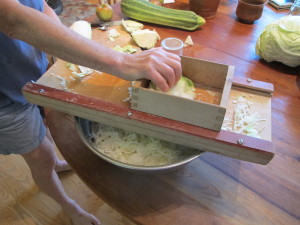Fermenting Foods
Many people believe that fermented foods – sauerkraut, yogurt, sourdough bread, for example – are better for you than other foods. For thousands of years people have fermented foods as way to preserve them, and scientists today note that fermenting foods can increase their content of vitamin C, thiamine and niacin, among other nutrients. Fermented vegetables help to promote a healthy gut and introduce beneficial bacteria into our bodies. And fermenting food is another way of preserving it for winter use.
We live in a society that minimizes contact with bacteria. Hand sanitizer is big business. Now probiotics (microorganisms introduced into the body for their beneficial qualities) are being sold and promoted in “live” yogurt and other probiotic preparations. But you can use your garden produce to make easy, tasty fermented foods that do much the same.
I recently met with a passionate food “fermentista”, Leslie Silver of Middletown Springs, Vermont and spent an afternoon making sauerkraut and other fermented foods. It’s easy. Leslie also told me about the 3rd Annual Vermont Fermentation Festival on October 3 at Green Mountain College in Poultney, Vermont. It is sponsored by RAFFL (www.rutlandfarmandfood.org) and organized by her. For $10 you can have a full day of learning!
Leslie explained that raw cabbage has naturally occurring bacteria that will ferment the sugars in the leaves without any introduction of bacteria on our part (most fresh fruits and vegetables has good bacteria, too). All we have to do is chop or finely slice the cabbage and add a teaspoon of salt for each pound of cabbage. The salt draws out the water and creates a brine. If you knead the salted cabbage like bread dough, soon there will be lots of liquid.
We packed chopped cabbage and other vegetables into wide-mouth quart jars and pressed out the air, allowing brine to cover the mix. Left open at room temperature the cabbage ferments and creates lactic acid and carbon dioxide that bubbles along, showing me that my sauerkraut is “working”. This kind of fermenting is called lacto-fermentation. (The lacto refers to lactic acid, not anything to do with milk).
Eventually the lactic acid brings the pH down to about 4.0, which stops the fermenting – and prevents other, harmful bacteria from affecting the food. Those same bacteria that cure the sauerkraut are beneficial to our gut.
If you want to learn how to make sauerkraut and other fermented veggies, I recommend working with an expert to really get first-hand knowledge of how to do it. We made 4 different recipes in 4 hours including 3 kinds of sauerkraut and a corn relish. All are delicious.
As an author (and a person of a certain age) I like to have a book in hand when learning a new skill. Leslie recommended Fermented Vegetables: Creative Recipes for Fermenting 64 Kinds of Vegetables in Krauts, Kimchis, Brined Pickles, Chutneys, Relishes & Pastes by Kirsten and Christopher Shockey, published by Storey Publishing. I got it, and like it. It has lots of good color photos and nice recipes. It explains the process well, without being overly technical.
The other book I got was a New York Times bestseller by Sandor Katz called The Art of Fermentation: An In-Depth Exploration of Essential Concepts and Processes from Around the World, published by Chelsea Green Publishing. This is also a great resource with information not only about fermenting vegetables, but also fruits, grains, milk, beans, meat and more. It has a glowing introduction from food writer Michael Pollan, who I trust. It’s excellent. The book is nearly 500 pages long, and seems to cover all aspects of fermenting, including lots of technical stuff.
Materials for fermenting veggies are minimal: You need a large bowl, containers and large sharp knife. Leslie also had a kraut board with 3 sharp blades. Run a cabbage across it and the shredded cabbage falls into the bowl.
We made small batches and put our krauts in wide-mouth glass jars. But, having fallen in love with specialty sauerkrauts, I have ordered from Gardeners Supply Company (www.gardeners.com or 888-833-1412) a 1.3 gallon Fermentation Crock kit, complete with lid and weights to keep the veggies in the brine (they tend to rise). I have old crocks, but this one has a water seal that allows the carbon dioxide to get out while keeping extraneous bacteria and yeasts out. For about $80, it seems like a good investment.
My krauts are tastier than any I’d ever had. In one I added fresh ginger, another has fennel seeds. It’s a good way to use kohlrabi, carrots, celeriac, too. I’ll be making more later this fall – once I get my new crock.
Henry is the author of 4 gardening books. He is not answering questions this week. His website is www.Gardening-Guy.com.



